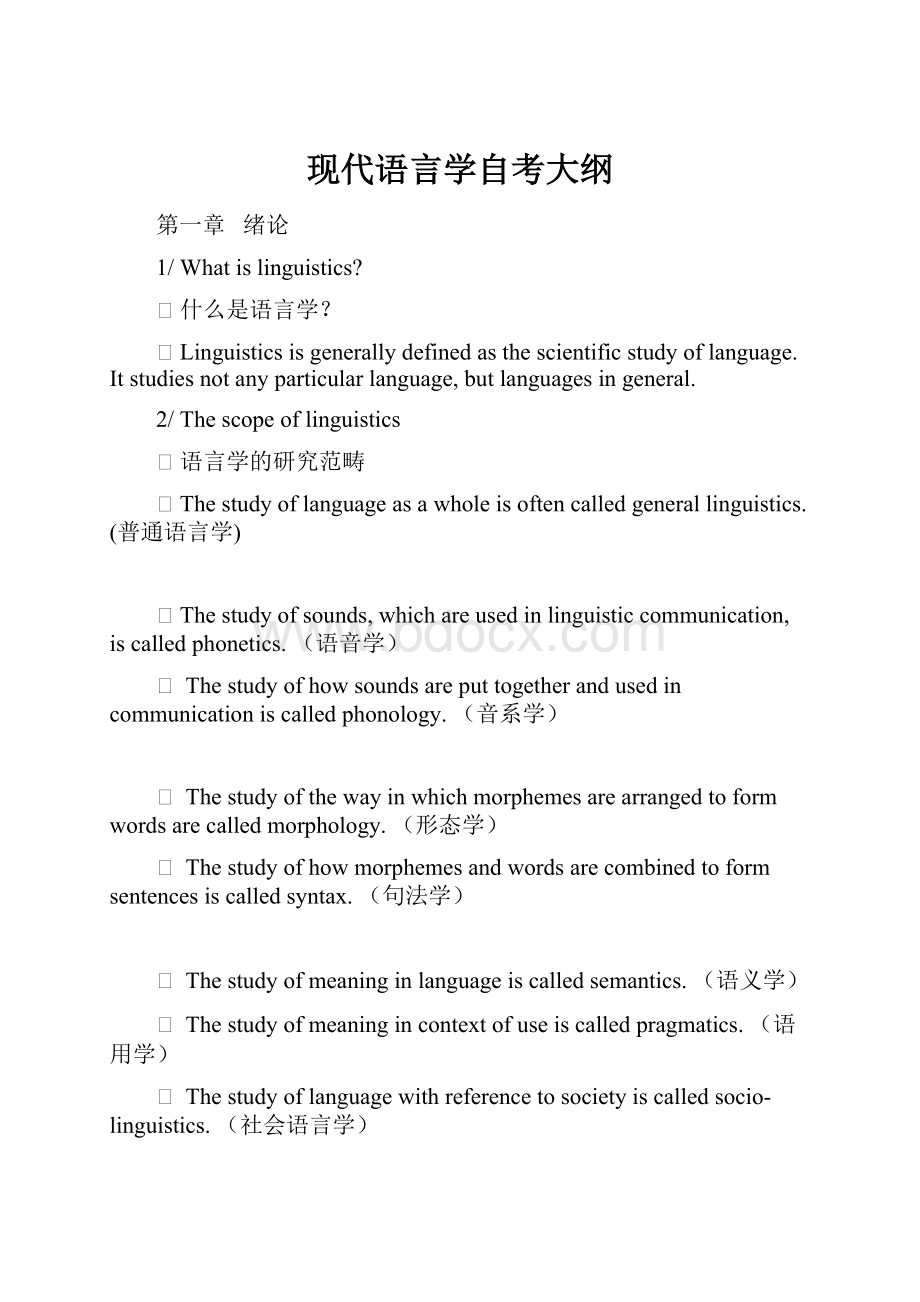现代语言学自考大纲.docx
《现代语言学自考大纲.docx》由会员分享,可在线阅读,更多相关《现代语言学自考大纲.docx(68页珍藏版)》请在冰豆网上搜索。

现代语言学自考大纲
第一章 绪论
1/Whatislinguistics?
¢什么是语言学?
¢Linguistics isgenerallydefinedasthescientificstudyoflanguage.Itstudiesnotanyparticularlanguage,butlanguagesingeneral.
2/Thescopeoflinguistics
¢语言学的研究范畴
¢Thestudyoflanguageasawholeisoftencalled generallinguistics.(普通语言学)
¢Thestudyofsounds,whichareusedinlinguisticcommunication,iscalled phonetics.(语音学)
¢ Thestudyofhowsoundsareputtogetherandusedincommunicationiscalled phonology.(音系学)
¢ Thestudyofthewayinwhichmorphemesarearrangedtoformwordsarecalled morphology.(形态学)
¢ Thestudyofhowmorphemesandwordsarecombinedtoformsentencesiscalled syntax.(句法学)
¢ Thestudyofmeaninginlanguageiscalled semantics.(语义学)
¢ Thestudyofmeaningincontextofuseiscalled pragmatics.(语用学)
¢ Thestudyoflanguagewithreferencetosocietyiscalled socio-linguistics.(社会语言学)
¢ Thestudyoflanguagewithreferencetotheworkingofmindiscalledpsycho-linguistics.(心理语言学)
¢Thestudyofapplications(astherecoveryofspeechability)isgenerallyknownas appliedlinguistics.(应用语言学)
¢Butinanarrowsense,appliedlinguisticsreferstotheapplicationoflinguisticprinciplesandtheoriestolanguageteachingandlearning,especiallytheteachingofforeignandsecondlanguage.
¢Otherrelatedbranchesinclude anthropologicallinguistics,(人类语言学) neurologicallinguistics,(神经语言学) mathematicallinguistics,(数字语言学)and computationallinguistics.(计算机语言学)
3/Someimportantdistinctionsinlinguistics
¢语言学研究中的几对基本概念
Prescriptiveanddescriptive
¢描写与规定
¢Ifalinguisticstudydescribesandanalyzesthelanguagepeopleactuallyuse,itissaidtobe descriptive,ifitaimstolaydownrulestotellpeoplewhattheyshouldsayandwhattheyshouldnotsay,itissaidtobe prescriptive.
¢Modernlinguisticsdiffersfromtraditionalgrammar.
¢Traditionalgrammarisprescriptivewhilemodernlinguisticsisdescriptive.
¢Thetaskoflinguistsissupposedtodescribethelanguagepeopleactuallyuse,whetheritis“correct”ornot.
Synchronicanddiachronic
¢共时和历时
¢Thedescriptionofalanguageatsomepointintimeisa synchronicstudy;thedescriptionofalanguageasitchangesthroughtimeisa diachronicstudy.Inmodernlinguistics,synchronicstudyismoreimportant.
Speechandwriting
¢口头语与书面语
¢Speechandwritingarethetwomajormediaofcommunication.
¢Modernlinguisticsregardsthespokenformoflanguageasprimary,butnotthewrittenform.
¢Reasons:
●1.Speechprecedeswriting;
●2.Therearestillmanylanguagesthathaveonlythespokenform;
●3.Intermsoffunction,thespokenlanguageisusedforawiderrangeofpurposesthanthewritten,andcarriesalargerloadofcommunicationthanthewritten.
Langueandparole[pə'rəul]
¢语言和言语
¢TheSwisslinguistF.deSaussuremadethedistinctionbetweenlangueandparoleearly20th century.
¢Langue referstotheabstractlinguisticsystemsharedbyallthemembersofaspeechcommunity,and parole referstotherealizationoflangueinactualuse.
¢Saussuremadethedistinctioninordertosingleoutoneaspectoflanguageforseriousstudy.Hebelieveswhatlinguistsshoulddoistoabstractlanguefromparole,todiscovertheregularitiesgoverningtheactualuseoflanguageandmakethemthesubjectsofstudyoflinguistics.
语言能力和语言运用
¢Competenceandperformance
¢ProposedbyAmericanlinguistN.Chomskyinthelate1950’s.
¢Hedefines competence astheidealuser’sknowledgeoftherulesofhislanguage,and performance theactualrealizationofthisknowledgeinlinguisticcommunication.Hebelievesthetaskofthelinguistsistodiscoverandspecifythelanguagerules.
4/Whatislanguage?
¢语言的定义
¢Language isasystemofarbitraryvocalsymbolsusedforhumancommunication.
¢Sapir,Edwarduses“ideas”“emotions”and“desires”inhisdefinition.
¢Hall,likeSapir,treatslanguageasapurelyhumaninstitution.
¢Chomsky’sdefinitionisquitedifferent,itfocusonthepurelystructuralpropertiesoflanguagesandtosuggestthatthesepropertiescanbeinvestigatedfromamathematicallyprecisepointofview.
5/Designfeatures
¢语言的甄别性特征
¢Designfeaturesrefertothedefiningpropertiesofhumanlanguagethatdistinguishitfromanyanimalsystemofcommunication.
¢AmericanlinguistCharlesHockettspecifiedtwelvedesignfeatures.
1)Arbitrariness
¢任意性(和约定俗成性)
¢ Itmeansthatthereisnologicalconnectionbetweenmeaningsandsounds.
¢Forinstance,thereisnonecessaryrelationshipbetweentheworddogandtheanimalitrefersto.Thefactthatdifferentsoundsareusedtorefertothesameobjectindifferentlanguagesandthatthesamesoundmaybeusedtorefertodifferentobjectsisanothergoodexample.
¢Althoughlanguageisarbitrarybynature,itisnotentirelyarbitrary.Somewords,suchasthewordscreatedintheimitationofsoundsbysoundsaremotivatedinacertaindegree.Thearbitrarynatureoflanguagemakesitpossibleforlanguagetohaveanunlimitedsourceofexpressions.
2)Productivity
¢能产性
¢Languageisproductiveorcreativeinthatitmakespossibletheconstructionandinterpretationofaninfinitelylargenumberofsentences,includingthosethattheyhaveneversaidorheardbefore.
3)Duality
¢结构二重性
¢Itmeansthatlanguageisasystem,whichconsistsoftwosetsofstructure,ortwolevels,oneofsoundsatthelowerlevelandtheotherofmeaningsatthehigherlevel.Atthelowerorthebasiclevel,thereisthestructureofindividualandmeaninglesssounds,whichcanbegroupedintomeaningfulunitsatthehigherlevel.Thisdualityofstructureordoublearticulationoflanguageenablesitsuserstotalkaboutanythingwithintheirknowledge.
4)Displacement
¢语言的移位性(突破时空性)
¢Itmeansthatlanguagecanbeusedtotalkaboutwhathappenedinthepast,whatishappeningnow,orwhatwillhappeninthefuture.Languagecanalsobeusedtotalkaboutourrealwordexperiencesortheexperiencesinourimaginaryworld.Inotherwords,languagecanbeusedtorefertocontextsremovedfromtheimmediatesituationsofthespeaker.
5)Culturaltransmission
¢文化传播性
¢Whilewearebornwiththeabilitytoacquirelanguage,thedetailsofanylanguagearenotgeneticallytransmitted,butinsteadhavetobetaughtandlearnedanew.
Chapter2Phonology 音系学
1.Thephonicmediumoflanguage
¢语言的声音媒介
¢Speechandwritingarethetwomediausedbynaturallanguagesasvehiclesforcommunication.
¢Ofthetwomediaoflanguage,speechismorebasicthanwriting.Speechispriortowriting.Thewritingsystemofanylanguageisalways“invented”byitsuserstorecordspeechwhentheneedarises.
¢Forlinguists,thestudyofsoundsisofgreaterimportancethanthatofwriting.
¢Thelimitedrangesofsoundswhicharemeaningfulinhumancommunicationandareofinteresttolinguisticstudiesarethephonicmediumoflanguage(语言的声音媒介).
¢Theindividualsoundswithinthisrangearethespeechsounds(语音).
2.Whatisphonetics?
¢什么是语音学?
¢Phoneticsisdefinedasthestudyofthephonicmediumoflanguage;Itisconcernedwithallthesoundsthatoccurintheworld’slanguages.
¢语音学研究的对象是语言的声音媒介,即人类语言中使用的全部语音。
threebranchesofphonetics
¢Articulatoryphonetics(发音语音学),itstudiesthespeechsoundsfromthespeaker’spointofview.Itstudieshowaspeakeruseshisspeechorganstoarticulatethesounds.
¢
¢Auditoryphonetics(听觉语音学),itstudiesthespeechsoundsfromthehearer’spointofview.Itstudieshowthesoundsareperceivedbyhehearer.
¢
¢Acousticphonetics(声学语音学),itstudiesthespeechsoundsbylookingatthesoundwaves.Itstudiesthephysicalmeansbywhichspeechsoundsaretransmittedthroughtheairfromonepersontoanother.
a
i
o
3. Organsofspeech
¢发音器官
¢Thepharyngealcavity咽腔 thethroat
¢Theoralcavity口腔 themouth
¢Thenasalcavity鼻腔 thenose
语音解剖图
发音器官图
¢4.Orthographicrepresentationofspeechsounds–broadandnarrowtranscriptions
¢语音的书写形式-宽式和窄式音标
IPA-InternationalPhoneticAlphabet
¢国际音标
¢Therearetwowaystotranscribespeechsounds.Oneisthetranscriptionwithletter-symbols(字母符号)only,calledbroadtranscription(宽式音标).Theotheristhetranscriptionwithletter-symbolstogetherwiththediacritics(变音符号),callednarrowtranscription(窄式音标).
p音的比较
¢对pit/spit中p音的比较:
¢pit中的p是送气音,在窄式音标中标为上标,写作:
[phit]
¢spit中的p是不送气音,在宽式音标中不作标示,写作:
[spit]
l音的比较
¢对leaf/feel/build/health中l音的比较:
¢Leaf中l在元音前,叫清晰音,在宽式音标中不作标示,写作:
[li:
f]
¢Feel中l出现在单词结尾,叫模糊音,在窄式音标中加变音符号[~]
¢Build中l出现在另一个辅音前,也叫模糊音,在窄式音标中也加变音符号[~]
¢Health中l出现在齿音前,受其影响叫齿音[l],在窄式音标中加变音符号[II]
5.ClassificationofEnglishspeechsounds
¢英语语音的分类
¢Consonants
¢Vowels
a)ClassificationofEnglishconsonants
¢按发音方式分
¢Stoporplosive塞音或爆破音:
[p][b][t][d][k][g]
¢Fricative擦音:
[f][v][s][z][W][T][s][V][h]
¢Affricate塞擦音:
[tF][dV]
¢Liquid流音:
[l][r]
¢Nasal鼻音:
[m][n][N]
¢Glide滑音:
[w][j]
¢
a)ClassificationofEnglishconsonants
¢按发音部位分
¢Bilabial双唇音:
[p][b][m][w]
¢Labiodental唇齿音:
[f][v]
¢Dental齿音:
[W][T]
¢Alveolar齿龈音:
[t][d][s][z][n][l][r]
¢Palatal硬腭音:
[V][tF][dV][i]
¢Velar软腭音:
[k][g][N]
¢Glottal声门音:
[h]
B)ClassificationofEnglishvowels
¢按舌头在口中的位置分:
¢Frontvowel前元音:
[i:
][i][e][A][a]
¢Centralvowel中元音:
[[:
][[][Q]
¢Backvowel后元音:
[u:
][u][R:
][R][a:
]
B)ClassificationofEnglishvowels
¢按口形的大小分:
¢Closevowel闭元音:
[i:
][i][u:
][u]
¢Semi-closevowel半闭元音:
[e][[:
]
¢Openvowel开元音:
[A][a]
¢Semi-openvowel半开元音:
[[][R:
][Q][R][a:
]
B)ClassificationofEnglishvowels
¢按唇形是否为圆分
¢Unroundedvowel不圆唇元音:
[i:
][i][e][A][a][[:
][[][Q][a:
]
¢roundedvowel圆唇元音:
[u:
][u][R:
][R]
B)Classifi